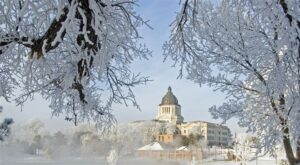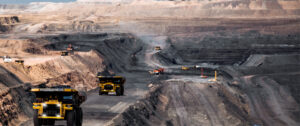
Friedland chairs Toronto stock exchange-listed miner Ivanhoe Mines which owns 79% of South Gobi Energy Resources which currently achieves the most export sales out of the Mongolian coal producers.
The tax on mining profits in Mongolia was 25% compared to Australia’s proposed 30% mining tax, Friedland said.
Mongolia had a clear advantage in that it neighboured (sic) its Chinese customers.
“They’re closer to China than your lucky island.” Friedland told the Diggers & Dealers Mining Forum last week.
Australia-listed Hunnu Coal is busy advancing several promising Mongolian thermal and coking coal projects with minimal start-up costs.
Wood can see some shocks ahead for Australia’s leading export industry.
“I think Australia is going to find it hard to compete with coal 600 kilometres from Beijing with labour at tenth of the price. Mongolia has a highly supportive government and has abolished the stupid taxes Australia is now contemplating. Australia has got some problems.”
He noted some other advantages of mining coal in Mongolia. “Australian mines are getting deeper and older. The easy, cheaper coal is gone. These deposits in Mongolia are open cut from surface – they haven’t even been developed yet, the best years are still coming.”
The Mongolian government is working hard to expand the coal industry and announced major railway investment plans last month.
Wood said one of the plans was a link from the giant Tavan Tolgoi coking coal field in the South Gobi province, where Hunnu Coal has projects, all the way up to northern Mongolia where it can link up to Russia’s Tran Siberian railway line.
From there, the coal is railed out for export through Vladivostok port on the east coast of Russia.
“That’s a very short boat ride to Korea and Japan,” Wood said.
He said the Koreans, Japanese and Russians were keen to invest in Mongolian rail.
Wood said the Japanese and Koreans were extremely keen to get access to Mongolian coal “so it’s not just about China; Mongolian coal will be seaborne and that is a real threat to Australia.”
“That’s why Friedland is saying these things.
“These things aren’t going to happen next month, they are not going to happen next year but people are making investment decisions in Queensland based upon five to ten years.
“In five to ten years they will be competing against Mongolian coal well and truly.”
In the light of the recent announcements about Mongolia supplying coal to China, perhaps it would be useful to refresh the Australian Government’s recall of this article that appeared in Mining of 9 August 2010 when the coking and thermal coal deposits were being opened up in the Gobi Desert in Mongolia.
While there is Australian investment in mining in that country, this assessment was given by the Canadian/American billionaire, Robert Friedland. He had then invested heavily in Mongolian coal, as now he is investing in gold and nickel in Australia. His parents were Holocaust survivors and Friedland from a young man has moved with shakers. For instance, as a student he managed an apple orchard in Oregon, where Steve Jobs, a friend would come to work at weekends – that “small enterprise’s” name came from that Jobs’ experience. Friedland himself is undoubtedly smart and well-connected.
Matthew Wood is Australian and was trained as a geologist with qualifications in mineral economics. At the time of this 2010 article he owned Hunnu Coal, but sold it two years later to Hong Kong interests. He has kept up his mining interests in Mongolia so much so that he was recently awarded the Order of the Polar Star, the highest award which the Mongolian government gives to non-Mongolians.
Hey, Prime Minister, when you held up that lump of coal in Parliament, were you sure it was Australian?
Peterborough, Coorey and the Goyder Line
Phillip Coorey has a very spare entry about his early life in his published biography. However, on radio recently he revealed that he was bought up in Peterborough in South Australia. He rattled off a few not very convincing reminiscences to the effect that, as a lad, he may have been committed to a life on the header there.
What he did mention was Goyder’s Line. Surprisingly, the radio interviewer seemed not to have heard of Goyder’s Line. This is a line drawn across a map of South Australia by George Goyder, the then state surveyor, who meticulously drew this imaginary line from just north of Ceduna to just north of Pinnaroo on the border with Victoria in the early 1860s.
Above the line, the land was unsuitable for long term cropping; below the line it was suitable for cropping. His findings were greeted with the normal sceptical response, even when recognition of the line was drafted into legislation. A few good rainfall years turned scepticism into scorn and the Act was soon repealed. Then the normal series of drought years followed, validating Goyder’s observations, and the Act reinstated.
If you drive north of Goyder’s line, there are the results of the scorn on view, ruined sandstone houses of those who knew better. The land along the Flinders Range is littered with evidence of how correct Goyder was.

An interesting observation when driving south is that fords across the many water courses are replaced by bridges, starting just north of Goyder’s Line; a significant reminder of the more reliable rainfall south of the Goyder?
Peterborough almost straddles the line – so cropping occurs for now. In any event Peterborough has another claim to fame besides Mr Coorey. It is where there is one of the two horse abattoirs in Australia. A horse abattoir differs from a knackery in that it produces horse meat suitable for export, mostly to Europe.
Goyder’s Line is the drought line. No other State has such a meticulously worked out differentiation of this arid land into its cropping and grazing potential.
As was reported: “George got on his horse and rode 3200 km east to west across the colony. Finally, in 1865, Goyder submitted his report and map to the state government.
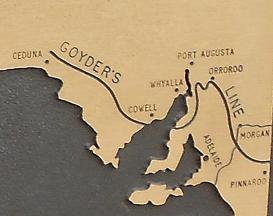
Goyder used old rainfall guides and changes in vegetation to produce his report. He noted that mallee scrub, which needs a higher rainfall, dominated in the south while saltbush which can exist on far less moisture was the main vegetation in the north. With his report showing that north of the line was drier and the south wetter, he discouraged farmers from planting crops north of his line, as he considered this land only suitable for grazing.”
Goyder’s Line thus remains. Thirty kilometres north of Peterborough is a ghost town called Dawson. It was set up in defiance of Goyder’s finding. It remains as a testimony to those who gambled their livelihood against the empirical evidence; and lost.
Peterborough survives as an outwardly prosperous town for now, but there is the ever-present threat of a shift of Goyder’s Line away from Peterborough because of climatic change.
Irrigation has enabled the Riverland to prosper above Goyder’s Line; and technology has been used to crop above Goyder’s Line, but it remains as a concrete reminder of scientific integrity.
Australia has produced an array of substantial scientists, whose renown does not rely on being puffed up by that bane of civilisation – the public relations spinning arachnoids. Goyder was one such scientist.
The night I danced with Nikki Savva
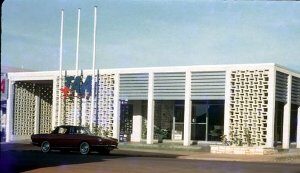
It was a time before Cyclone Tracey, and the Travelodge was the most prominent feature of Darwin. We were there campaigning for the LCP in the Northern Territory election, which resulted in the LCP winning 17 out of the 19 seats. The remaining two went to independents; Labor’s strategy left them with no seats. How much our visit to Darwin influenced the result is not clear. After all, there were no Aboriginal candidates in any of the electorates. All the candidates were Territorians, aka “whitefellas”.
In this bubble at the Travelodge that evening, there was much jollification, and I remember at one stage dancing with a young reporter from The Australian, Nikki Savva. It is a funny thing that memory of this brief encounter has stuck in my mind when other memories of that night have dissolved.
Eventually, I drifted off to my room staggering along with my colleague. He had the room opposite. It was a different image when I awoke next morning. The door of the room opposite was wide open. The room was empty. The room was now a wreck – it looked as it had been trashed, but when I walked across the corridor, I smelt the aftermath of a fire. The walls were covered with soot – there had been some water damage.
Blearily I went back to my room. It never occurred to me until later that I had not been evacuated. I had slept through the ruckus and nobody had thought to wake me. Such considerations came later when I learnt that my colleague had lit his mattress and was found in a smoke-filled bathroom, completely disorientated. His rescuer was a journalist travelling with the team. The fire brigade had been called, but I slept on. This was not the last time I slept though an awkward situation, nor that I escaped being burnt to death. Sometimes as the memory grew distant, in one of my rational moments, I believe that there is a force which determined that my time was not up – not then.
What was so different from today? There was no report in the media, although everyone knew but nobody talked about it – nobody wrote it.
I never knew who paid for the damage. It did not come across my desk.
Somehow I doubt whether that would be allowed to go unnoticed today.
However, so much has changed, but old habits die hard for me not acknowledging by name those who were in that burning room that night.
But I do remember Nikki Savva – a brief encounter and I doubt whether we have ever spoken since, such were our different career pathways. However, I enjoy her insights – and sometimes I agree with her, for what it is worth.
The charred Letter
In a slightly different mode, after the 1974 election I went to Snedden and said that the Liberal Party should have a Tasmanian strategy, since all the five House of Representatives seats were held by Labor, but were very winnable given that the number of electors is relatively small and local issues dominate. Labor was vulnerable if Whitlam’s lack of empathy for Tasmania could be countered. In fact, Lance Barnard being Whitlam’s deputy and a Tasmanian gave a certain sheen to Whitlam in the eyes of Tasmanians.
When Barnard retired from the seat of Bass not long after Fraser replaced Snedden, little or no credence was given to Snedden’s campaign to highlight that being distinct from the Whitlam haughtiness, Snedden cared for Tasmanian problems. There was even a shadow ministerial portfolio which Snedden gave to Bob Ellicott. It was pure populist politics.
As history showed, a retired army officer called Kevin Newman, well connected by marrying into a northern Tasmanian establishment family, won in a landslide. Many of the sage journalists identified it as a turning point in the eventual electoral demolition of Whitlam.
That is the background to this response the office received after letters seeking their priorities were sent to each of the Councils in Tasmania, which in those days numbered 79. This meant that some of the municipalities were formed when the populations of some was far greater than now.
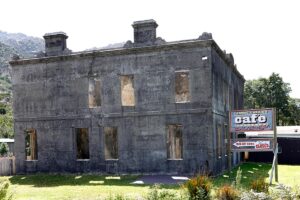
I was reminded of one response when driving through Gormanston on the shoulder between Mount Lyell and Mount Owen before the Murchison highway plunges down to Queenstown. Where once copper miners lived near the mine the municipality no longer exists. Now almost a ghost town, but back in 1974, it was a separate municipality. Many replies to the letters were received, but about six months after, a reply was received from the Warden of Gormanston apologising for the lateness, but the Council offices had been burnt down. The letter was written on decent note paper, but it confirmed the Warden’s excuse. The edges of the letter were severely charred.
Snow Gums
Some years ago, we were driving around Tierra del Fuego and on a bare hill there were these blanched fallen tree trunks, resembling the bones of long lost creatures. When I asked about them, my guide said that there had been a great fire about 50 years before, and in the harsh conditions of the island, trees had never grown back.
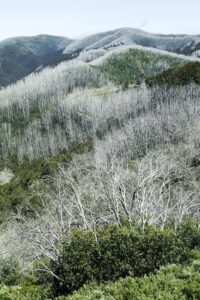
I remember a few years after a bushfire at Falls Creek in the Victorian Alps, had destroyed a great number of snow gums. They were whitened reminders among a blackened landscape slowly recovering. However, snow gums take 50 years to grow again, and before the fire there had been a huge stand of these beautiful trees. Now there are bleached reminders of nature’s revenge.
Near Mt Arrowsmith on the Tasmanian West Coast snow gums abound. They have one of most beautiful trunks of any of the eucalypts, along with leopard gums and salmon gums, not to mention the ghost gums of Central Australia. The trunks have dove grey and fawn markings against an essentially creamy white trunk. Bark is added decoration, lightly suspended from some the trunks, for snow gums are the contortionists of the eucalypt world, tossing themselves into bizarre shapes, but always maintaining their delicate beauty.
The road near Mount Arrowsmith is where the Murchison Highway is liable to be closed by snowfalls in winter, and it is here that a bushfire has left its signature. The bush has been reduced to a picket of black sticks where the only regeneration is blackberry bushes and bracken. It showed how long it had been since we had travelled the road from Hobart. Normally, we come down to the West Coast from Devonport – at least before COVID-19 closed off Tasmania. It showed how long it had been since we had driven from the south, because Hobart is further away than the northern Tasmanian cities.
I always believed that the West Coast of Tasmania was immune from bushfires because of its high rainfall, but in January 2016 there were multiple storms without much rain, but with a large number of lightning strikes which resulted in the West Coast burning in patches. Most the fires were concentrated in the northwest corner, but 1.2 per cent of the wilderness area was burnt. My belief that rainforest and moss lands would contain such a fire was disabused by the findings of an Inquiry. When the weather was dry, and today as I write this the temperature is 32oC in Strahan, then “all bets are off”. The West Coast of Tasmania will burn.
It is a wake-up call, especially as trading off an irreplaceable flora against a lean-to shed built by someone secretly growing marijuana and which can – and probably will – be easily rebuilt seems to be a no brainer. Those entrusted with fire control need to make decisions based on the greater good – saving endangered irreplaceable flora makes a lot more sense than sacrificing it to save a couple of sheds.
Here in the south-west of Tasmania preservation of the environment is paramount. The human population is small, but if the wilderness was destroyed in a bushfire, it does not have the ability to regenerate quickly – if at all. The indigenous pines grow slowly – that is why when you look at a fully grown Huon Pine, or King Billy Pine you are looking back at a thousand years; some romantics say that the forests are little changed from when dinosaurs walked.
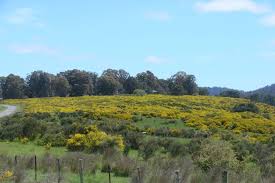
There are different priorities, because it is not only lightning strikes and man-made hazard reduction that can destroy the irreplaceable but also the disgraceful lack of attention that the Tasmanian government pays to the invasion of blackberry, bracken and particularly gorse, all together already creating a monument to West Coast neglect. A northern hemisphere native, gorse is a noxious weed here and a major fire hazard.
Look at the scene in the South-West four years after the fire. Just forgotten. It could be the harbinger of things to come.
Reflections on Matthias

Matthias Cormann is on the road again, metaphorically speaking. One of the pursuits which engages those trivia-centred people is to name five famous Belgians; and then for the master class five famous Walloons and five famous Flems. Matthias is neither of these. He was born of working class parents in the sliver of the country bordering Germany, which is naturally German speaking. Here the border has moved between the two countries depending on the political situation. He lived very close to the German border and his obvious affinity for Germany rather than the country of his birth is shown by his middle order award in 2018 from the German government for advancement of relations between Australia and Germany.
Cormann studied law and learnt Flemish at the first and French at the second university. He then went on an exchange Erasmus scholarship to Norwich, in the course of which he learnt English – all before he was 24 years of age. All that is on public record, together with his pursuit of a young woman to Perth.
Rejected, he went back to Belgium, but the second coming was very soon after. It seems an impetuous action, but then he was only 25. His quick eye obviously saw better opportunities in Western Australia rather than the country of his birth. Whether, as a member of small minority in a country riven by tribal strife where, in the job market, these tribal allegiances are translated into patronage, from which he was excluded, one can only speculate. However, if he is a serious contender for the OECD job, you can be assured there will be a rake going through the reasons for his flight from Belgium.
His adeptness at negotiating the political shoals in Australian politics were probably helped by a deferential mien which, as he rose up through the ranks, was retained as a courteous demeanour of appearing to listen. Perhaps having a very good grasp of where he was going and where he resides on the ladder of political influence was equally important.
He has no ideology; and that helps when some of your colleagues show moronic shrillness. However, his accent has been a useful weapon, when in others it could have been scorned. The accent is like a blade of steel – it gives him authority, even when he has blathered on and on, not answering questions as is his irritating wont.
Now he is trying his array of tricks on the world stage. Whether he survives the first cull is problematical given the Prime Ministerial aroma on this stage. Being a political chimney sweep covered in coal dust is not the image for selection for the OECD position. If Cormann presents a green visage to the members of the OECD, he needs to measure that against his welcome back into Australia, where his backers essentially have been the mining business community. Even a modern-day Metternich has limits to dissemblage.
However, what he may be angling for is the Australian ambassadorship to the OECD. The current incumbent could easily be recalled and there would be Matthias, like Banquo’s ghost, to haunt the new boss of the OECD – and incidentally polish his credentials on the world stage. Just a possibility.
Mouse Whisper
Kristi Noem sounds like the name of a Christmas elf or a doughnut; but she is in fact the Governor of South Dakota.
She was recently in Casa Blanca, where she was surprised by her bruised hero, Heel Spur. She did not have time to express her adoration before he looked at her contemptously and turning to the pianist snarled: “You played it for her. You can play it for me. If she can stand it, I can. Play it, Uncle Sam!”
Uncle Sam commenced playing, wistfully singing “You must dismember this…”
Tears formed in her eyes, “Oh, Heel, you know we’ll always have Pierre.”
